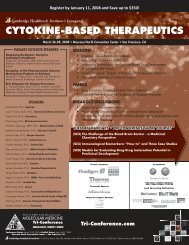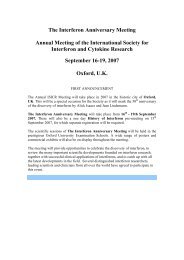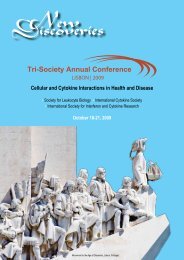9th Joint Meeting ISICR-ICS Cytokines & Interferons: From the ...
9th Joint Meeting ISICR-ICS Cytokines & Interferons: From the ...
9th Joint Meeting ISICR-ICS Cytokines & Interferons: From the ...
Create successful ePaper yourself
Turn your PDF publications into a flip-book with our unique Google optimized e-Paper software.
2010 Sidney &<br />
Joan Pestka<br />
AWARD WINNER<br />
2010 Sidney &<br />
Joan Pestka<br />
AWARD WINNER<br />
THE SIDNEY & JOAN PESTKA<br />
POST-GRADUATE AWARD:<br />
Dr. Anette H. H. van Boxel-Dezaire<br />
The Cleveland Clinic Foundation<br />
Lerner Research Institute<br />
Cleveland, OH<br />
Dr. Anette H. H. van Boxel-Dezaire is an immunologist who<br />
received her Ph.D. degree from <strong>the</strong> Faculty of Medicine at <strong>the</strong><br />
Vrije Universiteit (VU), Amsterdam, The Ne<strong>the</strong>rlands, in 2001.<br />
She has a longstanding interest in <strong>the</strong> involvement of cytokines<br />
in <strong>the</strong> pathogenesis and treatment of autoimmune diseases, in<br />
particular multiple sclerosis (MS). To obtain more knowledge of<br />
molecular biology and of interferon signaling pathways, she<br />
joined <strong>the</strong> laboratory of Dr. George R. Stark (Cleveland Clinic<br />
Foundation) in 2003. She employed a phospho-flow cytometry<br />
technique to study IFN‚-induced signaling in primary human B<br />
cells, T cells and monocytes in whole blood cultures, and found<br />
major differences in <strong>the</strong> activation of STAT1, STAT3 and STAT5<br />
between <strong>the</strong>se leukocyte subsets. In B cells and especially in<br />
CD4+ T cells IFN activated STAT5 in addition to STAT3, but<br />
only few primary human B cells activated STAT1, a finding that<br />
could not be explained by decreased levels of IFNAR2 or STAT1<br />
or enhanced levels of SOCS1 or relevant protein tyrosine<br />
phosphatases in B cells. The observed differential activation of<br />
STATs by IFN finally provides more insight how IFN- /‚<br />
increases <strong>the</strong> survival of primary human B cells and CD4+ T<br />
cells, but enhance <strong>the</strong> apoptosis of monocytes. Besides <strong>the</strong> cell<br />
type-specific signaling responses induced by IFN‚ in vitro and<br />
by IFN injection in MS patients, she also found differences in<br />
signal transduction between MS patients within given leukocyte<br />
subsets. Supported by <strong>the</strong> Career Transition Fellowship Award<br />
from <strong>the</strong> National Multiple Sclerosis Society, Dr. Van Boxel-<br />
Dezaire is currently testing <strong>the</strong> hypo<strong>the</strong>sis that, due to more<br />
inflammatory disease, clinically non-responsive MS patients have<br />
a distinct signaling response in certain leukocyte subsets<br />
compared to responders to IFN <strong>the</strong>rapy.<br />
THE SIDNEY & JOAN PESTKA GRADUATE<br />
AWARD:<br />
Seth G Thacker<br />
Graduate Research Associate<br />
Immunology Program<br />
University of Michigan<br />
Ann Arbor, MI<br />
Seth G Thacker is a Ph.D student in <strong>the</strong> immunology program at<br />
<strong>the</strong> University of Michigan. He is currently doing his <strong>the</strong>sis<br />
research in <strong>the</strong> lab of Mariana J. Kaplan. His interest in<br />
immunology and particularly autoimmunity started when from an<br />
early age he was exposed to devastating effects of rheumatoid<br />
arthritis. This directed his interest into doing research that could<br />
improve <strong>the</strong> wellbeing of those suffering from autoimmune<br />
diseases. His current project is exploring Type I IFNs role in <strong>the</strong><br />
increased risk of cardiovascular disease in patients with systemic<br />
lupus ery<strong>the</strong>matosus (SLE). Utilizing a microarray technology he<br />
has discovered a novel pathway by which IFN- inhibits vascular<br />
repair in endo<strong>the</strong>lial progenitor cells (EPCs) through <strong>the</strong><br />
modulation of IL-1‚ and IL-1 associated molecules and inhibition<br />
of VEGF. Seth has also characterized several lupus-prone mouse<br />
models and demonstrated that in those models dependent on<br />
type I IFNs, <strong>the</strong>y also demonstrate an abnormal vascular<br />
phenotype. This abnormal phenotype mirrors that seen in<br />
human SLE patients and is characterized by decreased numbers<br />
of EPC, endo<strong>the</strong>lial dysfunction and impaired vascular repair<br />
mediated by EPCs. His current studies are examining <strong>the</strong> direct<br />
role of type I IFNs in <strong>the</strong> aberrant vascular phenotype observed<br />
in <strong>the</strong> lupus-prone mice.<br />
FEBRUARY 2011 I VOLUME 18 I NO. 1 9







